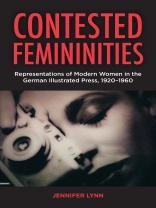In this comprehensive, long-view study on the concept of the Neue or Moderne Frau (New or Modern Woman) that spans the Weimar Republic, Third Reich, post-war period, and a divided Germany, Contested Femininities explores how different political and social groups constructed images of women to present competing visions of the future. It takes the highly contested representations of women presented in the illustrated press and examines how they emerged as crucial markers of modernity. In doing so it reveals the surprising continuity of these images across political periods and reflects on how debates over paid work, the gender division of labor in the household, the politics of the body, and consumption, played a central role in how different German regimes defined the Modern Woman.
قائمة المحتويات
List of Figures
Acknowledgments
Introduction: Modern Women in the German Illustrated Press
Chapter 1. Weimar Illustrierten and the Neue Frau: Working Women and Rationalized Housewives
Chapter 2. The Body of the Weimar Modern Woman
Chapter 3. Paid Labor and Motherhood for the Modern Woman in the Third Reich
Chapter 4. Fashionable, Feminine, and Modern: Women’s Bodies in the Third Reich
Chapter 5. Women in Trousers and Girls on the Stage: The Modern German Woman during World War II
Chapter 6. Occupier and Occupied: The Domestic Ideal and Women’s Labor in Rebuilding Germany
Chapter 7. Fashion Models and Beauty Queens: The Body of the Modern Woman as a Site of Recovery
Chapter 8. The Post-War Modern Woman: Labor, the Home, and Female Bodies
Chapter 9. The “Other” Germany: The Modern Woman Across the Border
Conclusion
Bibliography
Index
عن المؤلف
Jennifer Lynn is a Professor of History and Director of the Women’s and Gender Studies Center at Montana State University Billings.












